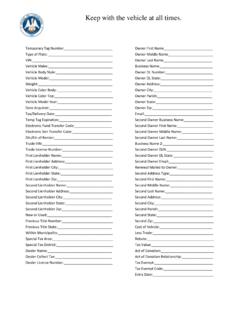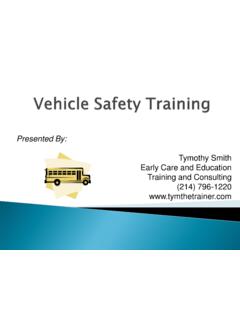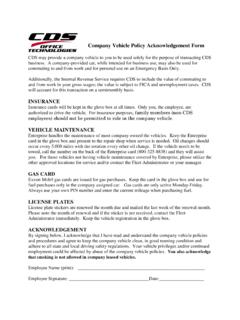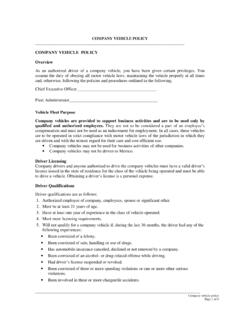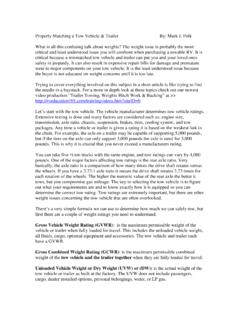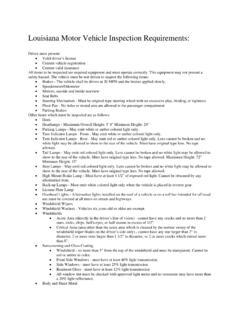Transcription of Vehicle Inspection Guide - Stadium Managers …
1 Vehicle Inspection GuideSeptember 2012 HomelandSecurityCreditsAll photographs, images, drawings, and other graphical material provided by the Technical Support Working Group (TSWG) for the Office for Bombing Prevention, Department of Homeland Security (DHS), unless otherwise photo: (left) Provided by DHS Office for Bombing Prevention, (right) Navy photo by Mass Communication Specialist 3rd Class David A. to Use This Guide1 Security WarningThis document is to be controlled, stored, handled, transmitted, distributed, and disposed of in accordance with Department of Homeland Security (DHS) policy. This information should be disseminated only to personnel on a need-to-know basis. This Guide is intended for use by local, state, federal, and private sector security partners as a reference for training and operations by emergency personnel in preparing for and responding to acts of to Use This Guide2 PurposeVehicle Inspection Guide PurposeThe purpose of this document, developed by the Technical Support Working Group (TSWG) for the Office for Bombing Prevention, DHS, is to provide guidelines to personnel assigned the responsibility of assessing and inspecting incoming traffic for the presence of explosive threats.
2 The information herein is not all inclusive and should be applied in conjunction with previous training, experience, and standard procedures and policies. Be aware that each case presents its own unique circumstances. In all cases, use common sense and do not conduct any operations that would place personnel, equipment, or facilities at book presents a comprehensive overview of methods to detect Vehicle borne IEDs. Not all methods will be appropriate for use in all situations. Leaders, Managers , and legal counsel should work together to ensure that these methods are employed in a manner consistent with legal requirements, the current threat level, and the facility s security to Use This BookThis book is divided into tabbed color-coded sections; the tabs separate sections and the colors correspond to the type of information and/or different Vehicle types.
3 Each tabbed Vehicle section has a Quick Review that covers the Hot Spots (likely hiding places) and Inspection Indicators that may call for increased attention. Following each Quick Review is a detailed description of how to conduct a thorough Inspection . Supplemental reference information and guidance are provided at the end of the book, including a reference section that provides amplifying information on Example Concealments, Explosive Materials, and Homemade Explosives, as well as bomb threat standoff available as a supplement to this Guide is a video (see inside back cover for more information).How to Use This Book4 Secure the Vehicle with an appropriate perimeter. Isolate the Vehicle and deny entry. Notify your chain of command and response the event a potential threat device is discovered: SINE mergency Response GuidelinesEmergency Response5 Quick Review Reference Table of ContentsSecurity Warning.
4 1 Vehicle Inspection Guide Purpose ..2 How to Use This Book ..3 Emergency Response Guidelines ..4 Safety and Security Guidelines ..7 Dos and Don ts ..9 Indicator Definition ..10 Interview Guidelines ..12 Detailed Interviewing Guidelines ..15 Passenger Vehicles .. General .. Cargo Automobiles .. Cargo Pickup Truck .. Cargo Flat Panel Vans .. Cargo Minivan .. Cargo SUVs .. and Tankers .. Non-Sleeper Day Tractors .. Interstate Sleeper Tractors .. Trailer Undercarriages .. Hot Liquid Asphalt Tanker .. Closed Hopper Vessel .. Gasoline Trailer .. Table of Contents6 Liquid Tanker .. Refrigeration Trailer .. Utility Vehicles .. Propane Tanker .. Septic Service Truck .. Box Trucks .. Garbage Trucks .. Dumpsters .. Dump Trucks.
5 Concrete Trucks/Mixers .. School Buses .. Commercial Buses .. Vehicles .. Camper/Motor Home .. Boats and Boat Trailers .. Information ..125 Example Concealments ..126 Explosive Materials and Devices ..130 Supplemental Information ..153 Bomb Threat Stand-Off Card ..154 Transportation Labels ..156 National Fire Protection Association Labels ..158 Quick Review Reference Table of Contents7 Safety and SecuritySafety and Security Guidelines Do not wear jewelry or other dangling items that can become snagged on a Vehicle . Wear brightly colored vests or hats so you can be seen easily by the Vehicle drivers. Always position yourself so that you are highly visible to traffic with good approach sight distance. Be aware of escape routes and/or areas that can shield you from a blast in case of emergency, and always face oncoming traffic.
6 Be aware of moving equipment in the Inspection areas. Always establish eye contact with the driver before approaching the Vehicle . Ensure that the engine is off and the parking brake is set prior to inspecting a Vehicle . Do not smell air from a tire. If the air contained within is contaminated, it may cause harm. Use caution when inspecting engines, exhausts, refrigeration coils, auxiliary heaters, and other components. They may be hot. Gloves can be worn for extra protection. Do not reach through or near cooling fan blades. Cooling fans can turn on even though the engine is not running. Ensure chock blocks are used where necessary. Do not smoke while inspecting. Combustible vapors may exist around vehicles. Do not support yourself on adjustable load support poles in cargo areas.
7 Seek supervisory assistance if you are unsure of how a specific Vehicle functions or of the potential risks involved with a cargo. Use a team approach to inspect, if Always designate an area (within sight of Inspection team if possible) where the driver and passengers are to remain at all times. The driver should be asked to place the keys on the dash. This will secure all mechanical movement of the Vehicle and shut down power. The driver should open all interior/exterior doors, hood, trunk, compartments, etc. Never get in a position where you can possibly be locked in a container. If there is only one security officer present, ask the driver and any passengers to move to a position where they can be kept within view of the security and SecuritySafety and Security Guidelines (cont.)
8 The value of using a detection dog should be assessed by the facility. If no canine support is available, the security officer will perform a walk-around Inspection of the Vehicle using a mirror with a creeper and a flashlight. Inspections should be done in a timely and efficient manner, which does not detract from the overall quality or safety of the process. The time it takes to conduct a Vehicle Inspection will vary based on the level of Inspection required and the size of the Vehicle . Stay alert for secondary devices! Never touch or move a suspicious and Don tsDo: Present a professional and positive image. Be assertive in questioning an individual and inspecting a Vehicle . Be aware of the current situation and know: Specific threats to your company/facility National Terrorism Advisory System threat alerts Available local support (bomb squad, etc.)
9 Establish a systematic and thorough Inspection technique to ensure no areas are missed or efforts duplicated. Maintain cultural t: Do not let your guard down. Do not inspect a Vehicle while the motor is running. Do not allow yourself to get into a vulnerable situation with respect to the Vehicle occupants. Do not perform search activities that violate legal limits or exceed the scope of your authority. Do not overlook items in plain sight. These are often the most overlooked. Do not touch or move discovered objects of and Don ts10 Definition IndicatorDefinition IndicatorAn indicator is an item, occurrence, condition, or situation that suggests the presence of illicit material, such as explosive materials and devices, or other illegal or prohibited Inspection Guide (VIG)September 2012 Interview12 Quick Reference Interviewing GuidelinesInterview Purpose: to gather information about an individual that may indicate a threat situation.
10 Information is gathered from the interview by: Observing the person s behavior Observing the Vehicle for physical abnormalities Questioning the driver/passenger Reading/recognizing deception, stress mannerisms, and the fight or flight mechanism Knowledge of local driver s behavioral cues and typical documents carried Noting the presence of consistent odors Background information required of the interviewer: Knowledge of local or typical traffic types Knowledge of Vehicle types Knowledge derived from driver/ Vehicle documents Knowledge of existing intelligence and patternsTypical Documentation to CheckAsk to see the following items as they pertain to your situation: Vehicle registration Vehicle insurance card Driver s license Medical insurance card (C) Logbook (C) Manifest (C) Shipping papers (bill of lading) (C) Itinerary (C) Tachygraph (paper disk that automatically records Vehicle use and schedule required for all countries)(C) = Commercial Vehicles Only13 Where are you going?
